Timothy R. Gaffney's Blog
November 26, 2019
Tipp City's forgotten brewer
 Tippecanoe detail view of 1858 Miami County map shows "I. Clark" brewery at bottom center.
Tippecanoe detail view of 1858 Miami County map shows "I. Clark" brewery at bottom center.© 2019 Timothy R. Gaffney
Note: Links to census records go to pages in FamilySearch.org. You will need to create a free account to access them.
Call this Dayton Beer’s first extra chapter.
It’s about the brewing history of Tipp City in Miami County, Ohio—a history that eluded my research when I was writing my book—and a related whiskey scandal that went all the way to the U. S. Supreme Court.
The lack of any clues to a brewery in Tipp City was puzzling and frustrating at the time. Granted, what was originally named Tippecanoe City had only about 1,000 residents in the 1860s and ‘70s. But my research was finding evidence of at least one small brewery in every city and village I studied, no matter how small—even tiny New Madison in Darke county, with about 500 residents in the 1870s and less than 1,000 today. I suspected Tipp City had had one as well, but I had to move on. I had a deadline.
Dayton Beer came out in July 2019. In September, I attended one of Cicerone David Nilsen’s educational tasting sessions at the Tipp City Public Library. While I was there, I explored the library's local history room. I was already familiar with most of the resources I found. On a whim, I took down a large bound volume of local newspapers from the 1860s, wondering I’d come across a brewery advertisement.
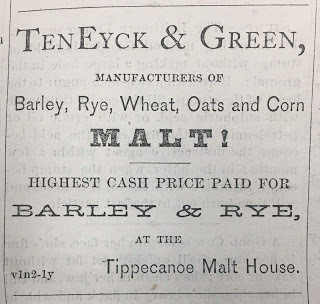
I didn’t. But I found something close: an 1869 ad for TenEyck & Green, proprietors of a local malt house. Malt is a cereal grain such as barley that has been made to germinate, developing enzymes that are important to the brewing process. Whenever I found records of a brewery in my research, I usually found a malt house nearby. TenEyck was an unusual name, and I hoped using it as a search term in databases such as Google Books might also turn up references to a brewery.
And that's what happened. I found TenEyck mentioned in A history of Miami County, Ohio, 1807-1953, a book published in 1953 by Miami County’s Sesquicentennial Historical Committee—a book that had escaped my attention earlier. In it, I found this brief passage:
"M. B. Dyche and Walter Norrie established a Malt House on South First Street in 1854. After several successive owners, the business was purchased by William Green and Robert TenEyck, 1868, who operated it for many years. The brewery, south of the malt house was started by Isachaar Clark in 1855, with James Smith as engineer and brew-master. In 1867 the brewery was sold to the Liquor Industry."In all the databases I’d searched, I’d rarely found anyone named Isachaar. I figured searching for Isachaar Clark would be as easy as searching for TenEyck. I was wrong. For one thing, “Isachaar” was more often spelled “Issachar” or “Isachar,” apparently just different enough to evade detection. And, as I discovered, the Clark name was ubiquitous in Tippecanoe in the nineteenth century.
So it took a lot of digging, even searching line-by-line through nineteenth century census records, to find the barest facts. Since my book was already published, why even try? Well, I had agreed to speak at the Tipp Library on November 20, and I wasn’t about to show up without at least a scrap of information about its hometown brewing history. So I kept digging. Here’s what I learned.
Issachar Clark, Tippecanoe’s Forgotten BrewerUnlike numerous other Miami Valley brewers, Issachar Clark (1820-1885) had not come to America penniless from one of the German states. He was the locally born son of a local legend. His father, John Clark, was a Maryland native who had come to Miami County as a pioneer farmer. He had worked hard, prospered and accumulated large tracts of land that included the townsite itself. He laid out Tippecanoe in 1840 and named it, according to the Tippecanoe Historical Society. (It was changed to Tipp City in the 1930s to eliminate confusion with another Ohio town of the same name.)
I couldn’t independently confirm Issachar started his brewery in 1855, but an 1858 map confirmed it was there by that time. It stood just south of Broadway between First Street and the canal. (A Tip Top Canning plant now occupies the site.) The map also showed the Clarks owned large tracts of land.
It isn't clear to me how deeply Issachar involved himself in the brewery. The Miami County history book mentioned a brewmaster and engineer named James Smith. The 1860 census for Tippecanoe listed a James Smith as a “brewer and maltster,” while it listed Issachar as a farmer with real estate valued at $22,000. In 1870 it listed Issachar as a retired merchant, and in 1880 it described him as a retired maltster.
Why Issachar is so obscure today is odd. Local historians lionized his father and his brothers John and Levi with biographical sketches while all but ignoring Issachar. He might not have achieved the success his father and brothers did despite a privileged start in life. Census records showed the value of his real estate holdings declining over the years with no corresponding growth in personal wealth: from $22,000 in 1860, he was down to $12,000 in 1870, and by 1880 he and his wife Sarah were living with their daughter Elizabeth Bauslin and her husband David H., a Lutheran minister. Sometime later they all moved to Kansas City, Missouri, where Issachar died in 1885. He rests there today in Union Cemetery.
But what of the brewery? Issachar apparently sold it as A History of Miami County asserted, but not necessarily of his own will. A deed transfer record in the Miami County Recorder’s Office in Troy shows Sidney L. Chaffee (1819-1898) bought the lots it stood on in 1867 for $13,666 as a result of a court-ordered sale.
What Chaffee did with the brewery is more of a mystery. I found no further mention of it. But census records indicate a brewery was operating in Tippecanoe for at least a few years after Chaffee bought Clark's. The 1870 census listed two men as brewery workers. What brewery they worked for and who owned it, I didn’t learn. Smith, Clark’s apparent former brewmaster, was listed as a maltster. Chaffee was listed as a retired farmer, with an impressive real estate value of $190,000.
Sidney Chaffee and the whiskey scandal
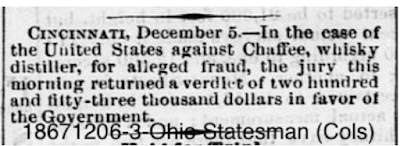
The deed transfer record identified Sidney Chaffee as an individual buyer, but he was also a partner in H. D. Chaffee and Co., which had various business interests including a distillery. And the same year Chaffee bought the brewery, the U. S. district court in Cincinnati won a judgement against Chaffee and Co. for not paying revenue taxes on whiskey it had been shipping up and down the Miami and Erie Canal. I found spotty news coverage of its legal woes in Chronicling America, a free online newspaper database provided by the Library of Congress.
The government originally sought more than a million dollars, claiming Chaffee and Co. had moved 200,000 gallons of booze on the canal without paying taxes on it between July 1864 and October 1866. Testimony and records convinced a jury the amount was far less, but in December 1867 it awarded the government $235,680, according to a review of the case (press reports gave different figures.)

Besides the jaw-dropping size of the fine on a small distillery in a small midwestern town, the trial also produced a bit of drama. The Dec. 24, 1867 Chicago Tribune reported the defendants claimed some jurors had tried to bribe them, offering to find in their favor in return for cash to four jurors. The alleged bribes were in two anonymous letters they submitted to the court, but the evidence apparently didn’t sway the judge.
Chaffee and Co. appealed the verdict on other grounds all the way to the U.S. Supreme Court, which in 1873 ruled the judge in Cincinnati had made a procedural error. The court reversed the judgement and sent the case back to the district court for retrial. Two years later, the March 12, 1875 Cincinnati Star reported a jury had sided with the government agin, but this time it only awarded $500.
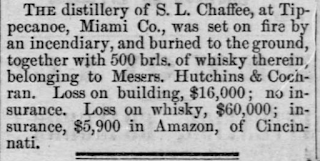
In the meantime, a fire on Jan. 6 burned the Chaffee distillery to the ground. Press reports of the damage ranged up to $16,000 on the building and $60,000 on the whiskey stored in it. The Highland Weekly, a newspaper in Hillsboro, Highland County, asserted the distillery “was set on fire by an incendiary.”
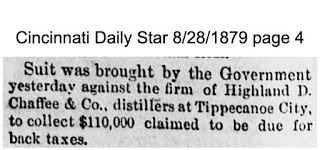
I didn’t learn if the distillery was rebuilt, but as late as 1879 Chaffee and Co. was making news over another government lawsuit that claimed it owed $100,000 in back taxes.
This is where I ended my research. I’m sure more can be learned about Issachar Clark, his brewery, the ill-fated distillery and the government’s attempts to wring tax revenues from it. I included links to some of my sources in this post in case anyone is interested continuing this research.
Dayton Beer: A History of Brewing in the Miami Valley is available in Dayton-area bookstores and online at Amazon.com, which also offers it as a Kindle edition.
Published on November 26, 2019 12:49
November 4, 2019
Dayton Beer Book Tour: Nov-Dec
 Undated photo of Star Brewery employees. Courtesy Minster Historical Society.
Undated photo of Star Brewery employees. Courtesy Minster Historical Society.The book tour for Dayton Beer: A History of Brewing in the Miami Valley kicked off in August with book events at brewpubs and tap houses across the region. I wrapped it up in October with a book discussion and signing at Mother Stewart's Brewing Co. in Springfield.
Now, the tour schedule for the remainder of 2019 is taking shape. Below are the public events on my calendar as of November 4. Copies of Dayton Beer will be available for sale at all events. And I'm still accepting new engagements, so contact me (daytonbeerbook at gmail) if you're interested in having me talk about local brewing history or sign books at one of your events.
But first, I want to give shout-outs to Libby Ballengee and the Gem City Podcast for making Dayton Beer the subject of Podcast #793, and to Bill Kincaid of the Celina Daily Standard for his feature about my event at Moeller Brew Barn in Maria Stein.
November
Thursday Nov 7: Wapakoneta
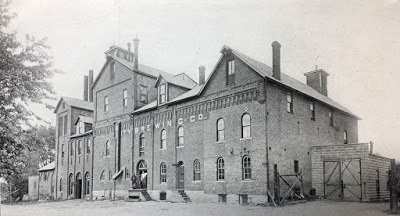 City Brewing Co. in Wapakoneta from the 1917 Auglaize County Atlas.
City Brewing Co. in Wapakoneta from the 1917 Auglaize County Atlas.I'm honored to be the guest speaker at the Auglaize County Historical Society's annual meeting. (See the recent article in the Sidney Daily News .) I'll discuss what I learned about the county's long-forgotten brewers and breweries, and how the region's German heritage influenced the industry locally. Did you know tiny Minster was home to a brewery that rivaled Dayton's largest? Or that New Bremen once had two small breweries? The meeting will begin at 7 p.m. in the St. Joseph Catholic Church Parish Life Center on South Blackhoof Street, south of West Pearl in Wapakoneta.
Thursday Nov. 14: Troy
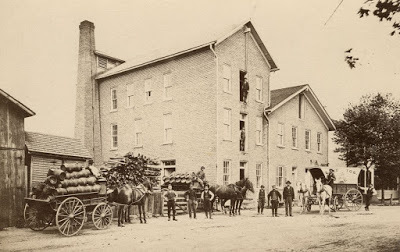 Undated photo of Henne Brewery, workers and wagons. Courtesy Troy Historical Society.
Undated photo of Henne Brewery, workers and wagons. Courtesy Troy Historical Society.I'll speak at the Troy-Miami County Public Library in a joint program with the Troy Historical Society about the county's long brewing history. The tradition of brewing there is as old as anywhere in the Miami Valley, but prohibition efforts at the state level wiped out its breweries in 1909, long before the 18th Amendment banned alcoholic beverages nationwide. It's said Piquads wept as Carl Schnell dumped his brewery's beer into the Great Miami River. And the Henne Brewery in Troy sent men and boys scrambling for cans and cups as it drained its last batch into the Miami and Erie Canal. I'll speak at 6:30 p.m. at the library, 419 W. Main Street in Troy.
Wednesday Nov 20: Tipp City
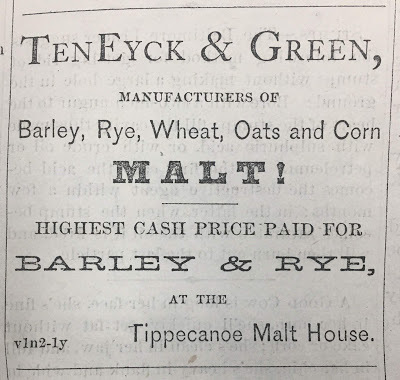 This 1869 Tippecanoe City Herald ad convinced me a brewery must have been nearby, and it was.
This 1869 Tippecanoe City Herald ad convinced me a brewery must have been nearby, and it was.When I researched my book, I tried but failed to find any evidence of a brewery in Tipp City. It bothered me because I had found a brewery in nearly every village I researched, no matter how small. It wasn't until I visited the Tipp City Public Library in September, after my book was already off the press, that I chanced upon a clue that ultimately led me to information about Tipp City's long forgotten brewer and his brewery. I'll share what I've learned so far in a joint program with David Nilsen, a certified cicerone and writer. David is well known to Tipp City library patrons for his beer tastings, pairings and classes, but this will be my first appearance there. The program will begin at 6:30 p.m. at the library, 11 E. Main Street in Tipp City.
December
Thursday Dec. 12: Centerville
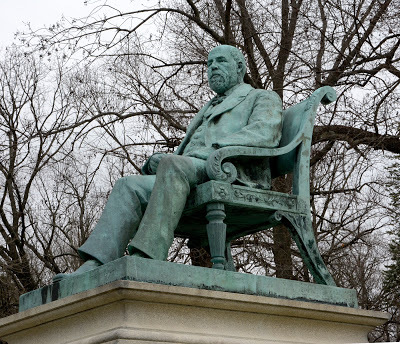 Adam Schantz monument at Woodland Historic Cemetery and Arboretum. Photo by Timothy R. Gaffney
Adam Schantz monument at Woodland Historic Cemetery and Arboretum. Photo by Timothy R. GaffneyThe Washington-Centerville Public Library has invited me to speak about the Dayton region's early brewers at Woodbourne Library. I'll follow Angie Hoschouer, PMP, director of development and marketing at Woodland Historic Cemetery and Arboretum, who will present her popular "Bottoms up! Brewers of Dayton" program. The program is free, but please register here to ensure adequate seating. It's scheduled for 6:30-8:30 p.m. at Woodbourne Library, 6060 Far Hills Ave., Centerville.
You can download and print a copy of my schedule here.
Published on November 04, 2019 05:00
October 7, 2019
Moeller Brew Barn next on Dayton Beer tour
 Undated photo of workers and wagons in front of the Star Brewery in Minster. Courtesy Minster Historical Society.
Undated photo of workers and wagons in front of the Star Brewery in Minster. Courtesy Minster Historical Society.© 2019 Timothy R. Gaffney
Here's the press announcement of my upcoming event at the Moeller Brew Barn in Maria Stein:
New book reveals western Ohio's hidden brewing historyDAYTON, Ohio—Ohio author Timothy R. Gaffney will visit the Moeller Brew Barn in Maria Stein on Saturday, Oct. 12, from 1 to 3 p.m. to share secrets about western Ohio’s long-hidden history of beer brewing.
Nick Moeller’s thriving craft brewery in rural Mercer County is one of several Gaffney spotlights in his new book Dayton Beer: A History of Brewing in the Miami Valley (The History Press, $21.99.) It places modern craft breweries like Moeller’s—including his newest one in Troy—in the context of more than two centuries of regional brewing history. It also explores how regional and global trends influenced local brewing, such as the building of the Miami and Erie Canal and German migration.
Gaffney searched thousands of records in local libraries, historical societies and county offices across the region as well as ancestry databases to peel back the years and show how commercial brewing was among the first industries in early Ohio settlements.
For example, Franz Lange’s Star Brewery in rural Minster grew into the powerhouse producer of Wooden Shoe beer, a once-famous brand that outlived Prohibition. Even the region’s smallest towns had their own breweries. Dayton Beer reveals colorful stories about brewers in New Bremen, Union City and even tiny New Madison.
At Moeller Brew Barn, Gaffney will present the latest information from his ongoing research into Mercer County’s early brewers. One was Philip Schmitt, a German immigrant said to have built a brewery in the woods a few miles from Maria Stein in 1855.
Gaffney will also sign books, and books will be available for sale.

Moeller Brew Barn is one of the stops on Gaffney’s unique “History and a Pint”™ book tour of the region’s brewpubs and tap houses. His next appearance will be at Mother Stewart’s Brewing in Springfield on Thursday, Oct. 17.
An internationally published writer, author and photographer, Gaffney is known mainly for his aviation and space writing. He made brewing the subject of his 16th book when he became intrigued by how craft brewers were often using local history and culture to brand their businesses and products.
Gaffney blogs at dayton-beer.com. He tweets as @DaytonBeerBook and uses hashtag #daytonbeerbook.
Who: Dayton Beer author Timothy R. Gaffney
What: Book talk and signing
Where: Moeller Brew Barn, 8016 Marion Drive, Maria Stein, Ohio
When: Saturday, October 12, 1-3 p.m
About the author
Timothy R. Gaffney was born in Dayton in 1951 and has lived most of his life in the Miami Valley. After earning a bachelor’s degree from The Ohio State University in Columbus in 1974, he worked for the Piqua Daily Call, the Kettering-Oakwood Times and the Dayton Daily News, where he took early retirement in January 2007. He held positions as assistant media relations director for Wright State University and director of communications for the National Aviation Heritage Area. He is a volunteer trustee for the United States Air and Trade Show Inc., the nonprofit producer of the Vectren Dayton Air Show. He lives in Miamisburg, Ohio, with his wife, Jean. They have four grown children, two grandchildren and two dogs.
About Dayton Beer
Title: Dayton Beer: A History of Brewing in the Miami Valley
Publisher: The History Press, Mt. Pleasant, SC
ISBN: 9781467138925
Retail price: $21.99
Format: 6x9, softcover, 192 pages
Released: July 22, 2019
Published on October 07, 2019 03:15
September 30, 2019
Dayton Beer October events


© 2019 Timothy R. Gaffney
If you’re a tinkerer, crafter, engineer or manufacturer—if you like to make stuff with your hands—the Make it Dayton Festival is for you. Held at Dayton History’s Carillon Historical Park on Saturday, Oct. 5, it will be a gathering of tinkerers, crafters, engineers and hobbyists who reflect Dayton’s heritage of invention and manufacturing.
One of the things Dayton has a long history of making—over more than two centuries—is beer. I’ll share some of that history from 3 to 5 p.m. in Carillon Brewing’s Bier Hall. Copies of my book Dayton Beer will be for sale in the park’s gift shop and in Carillon Brewing itself, and I’ll be happy to sign them.
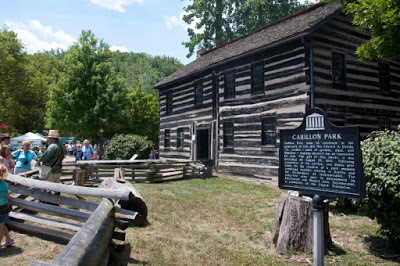
Named for its iconic musical bell tower, Carillon Historical Park is a 65-acre, open-air museum that preserves and interprets stories of Dayton’s inventions and inventors. Among its most historic exhibits are George Newcom’s Tavern, Dayton’s first permanent building, and the restored 1905 Wright Flyer III, the world’s first practical airplane. (The Wright brothers weren't brewers, but Newcom built Dayton's first brewery of record next to his tavern around 1810.)
Carillon Brewing is a reproduction brewery and restaurant where you can see how Dayton’s early brewers made beer. It serves historically brewed beers, and its menu reflect the fare Dayton’s predominantly English, German and Irish population would have found.
Make it Dayton is a grassroots group of people who, quite simply, like to make things. The festival is its biggest annual gathering and features demonstrations of everything from blacksmithing to robotics. The festival runs from 9:30 am to 5 pm. Admission is free to Dayton History members and $12 per adult to non-members, with discounts for seniors and children.
But Carillon Brewing is open to the public at no charge, and my presentation will be free. So stop in, have a pint and learn about Dayton’s rich brewing history.
This event will kick off my October “History and a Pint”™ book tour.
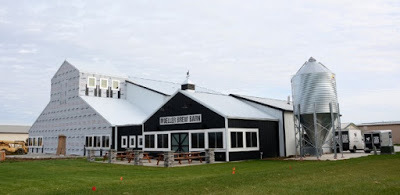 Moeller Brew Barn during expansion in 2018
Moeller Brew Barn during expansion in 2018October 12: Moeller Brew Barn
I’ll be at the Moeller Brewer Barn, 8016 Marion Drive, Maria Stein, in southeastern Mercer County, from 1 to 3 pm on Saturday, Oct. 12. I'll talk about brewing history in that region. Nearly every community had a brewery at one time or another in the 19th century, and I pieced together the stories of several in rural counties by combing hundreds of old records, newspaper clippings and old history books. Even tiny New Madison and Union City had breweries, and Minster’s Wooden Shoe beer was known and enjoyed across many states, before and after Prohibition.
I’m continuing to uncover old brewing locations. Even since my book was published in July, I’ve found new evidence of long-ago breweries—including one carved out of the woods in 1855 just a few miles from where Moeller Brew Barn stands today. (Just why its owner decided to build a brewery miles from the nearest sizable village is something I’m still trying to learn.)
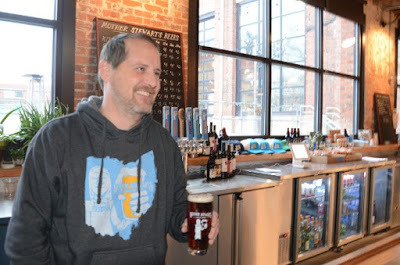 Kevin Loftis, Mother Stewart's co-owner
Kevin Loftis, Mother Stewart's co-ownerOctober 17: Mother Stewart’s
My third October event will take me to Mother Stewart’s Brewing, 102 W. Columbia St., Springfield, from 6 to 8 pm on Thursday, Oct. 17. I’ll tell the story behind the brewery’s name and talk about Springfield’s own rich brewing history—including a woman who owned a brewery there in the 1860s and a prohibition-era raid that sent several Springfield brewers to prison.
If you already have Dayton Beer I'll be happy to sign it, and I'll have books available for sale.
Published on September 30, 2019 08:05
September 16, 2019
Lock 27 and the Miami canal


© 2019 Timothy R. Gaffney
One of the brewpubs that piqued my interest in the Dayton region's brewing history was Lock 27 Brewing.
The name is an obscure reference to an important part of the Miami Valley's history—one that influenced the development of the region's brewing industry in the 19th century.
Lock 27 has two locations: its original one at 1035 South Main Street in Centerville, and one at Dayton Dragons Plaza downtown, where I'll be Wednesday evening, Sept. 18.
It was one of several local brewpubs I noticed that drew on local history to brand themselves or their products, and consequently led to my writing Dayton Beer: A History of Brewing in the Miami Valley. "Lock 27" is a nod to the Miami and Erie Canal, which was once the transportation artery that connected the Miami Valley to Cincinnati and Toledo.
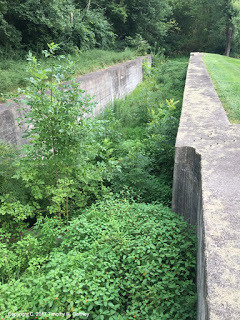 Lock 27 South of the Miami & Erie Canal
Lock 27 South of the Miami & Erie CanalWhen I interviewed him for my book, founder and owner Steve Barnhart said he wanted a name that would tie his brewery to the local region. "It's all about local in a lot of ways," he said.
He felt Dayton's aviation heritage was overused, so he began looking for other significant parts of the region's history and soon came upon the canal.
p.p1 {margin: 0.0px 0.0px 0.0px 0.0px; font: 14.0px Helvetica} "I knew [the canal] existed, but I really didn't pay a whole lot of attention to it. Once I started reading about it, it was fascinating," he said.
Looking for local canal sites, he found Lock 27 South, also known as the Sunfish Lock, which still exists along the canal's path just south of Miamisburg. He decided to name his brewpub after that lock.
His second location reflects another trend among craft microbreweries, that of repurposing old urban buildings. Lock 27's downtown brewpub faces the Dayton Dragons plaza from within the historic General Motors Delco building at 329 E. First Street, a space it shares with Delco Lofts apartments.
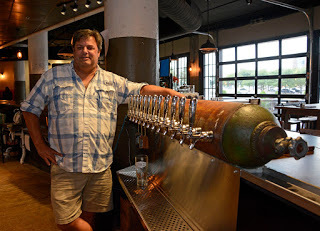 Steve Barnhart
Steve BarnhartBarnhart kept elements of the building's industrial past in the design for Lock 27's interior space. One example is the battery of beer taps built into an old welding tank.
Barnhart said drawing on local history is a way brewpubs can connect with their local customers. "Each of us has our following and each of us draws from our local community," he told me.
Which makes Lock 27 a great place to talk about local brewing history, and that's what I'll be doing there between 6 and 8 p.m. on Wednesday, Sept. 18. Grab a pint and join me. I'll sign your book, and copies will be available for sale.
p.p1 {margin: 0.0px 0.0px 0.0px 0.0px; font: 14.0px Helvetica}
Published on September 16, 2019 07:18
August 19, 2019
Miamisburg breweries—then and now
 p.p1 {margin: 0.0px 0.0px 0.0px 0.0px; line-height: 14.0px; font: 12.0px Times; -webkit-text-stroke: #000000} p.p2 {margin: 0.0px 0.0px 0.0px 0.0px; line-height: 14.0px; font: 12.0px Times; -webkit-text-stroke: #000000; min-height: 14.0px} p.p3 {margin: 0.0px 0.0px 0.0px 0.0px; line-height: 14.0px; font: 13.0px 'Times New Roman'; -webkit-text-stroke: #000000} p.p4 {margin: 0.0px 0.0px 0.0px 0.0px; line-height: 14.0px; font: 13.0px 'Times New Roman'; -webkit-text-stroke: #000000; min-height: 16.0px} span.s1 {font-kerning: none} span.s2 {text-decoration: underline ; font-kerning: none; color: #042eee; -webkit-text-stroke: 0px #042eee} span.s3 {font: 12.0px Times; font-kerning: none} span.s4 {font: 13.0px 'Times New Roman'; font-kerning: none} p.p1 {margin: 0.0px 0.0px 0.0px 0.0px; line-height: 17.0px; font: 15.0px Times; -webkit-text-stroke: #757575} span.s1 {font-kerning: none}
p.p1 {margin: 0.0px 0.0px 0.0px 0.0px; line-height: 14.0px; font: 12.0px Times; -webkit-text-stroke: #000000} p.p2 {margin: 0.0px 0.0px 0.0px 0.0px; line-height: 14.0px; font: 12.0px Times; -webkit-text-stroke: #000000; min-height: 14.0px} p.p3 {margin: 0.0px 0.0px 0.0px 0.0px; line-height: 14.0px; font: 13.0px 'Times New Roman'; -webkit-text-stroke: #000000} p.p4 {margin: 0.0px 0.0px 0.0px 0.0px; line-height: 14.0px; font: 13.0px 'Times New Roman'; -webkit-text-stroke: #000000; min-height: 16.0px} span.s1 {font-kerning: none} span.s2 {text-decoration: underline ; font-kerning: none; color: #042eee; -webkit-text-stroke: 0px #042eee} span.s3 {font: 12.0px Times; font-kerning: none} span.s4 {font: 13.0px 'Times New Roman'; font-kerning: none} p.p1 {margin: 0.0px 0.0px 0.0px 0.0px; line-height: 17.0px; font: 15.0px Times; -webkit-text-stroke: #757575} span.s1 {font-kerning: none} 
© 2019 Timothy R. Gaffney
When it opened in 2013, the Star City Brewing Co. revived a piece of Miamisburg history.
Built in 1828 as a sawmill skirting the Miami and Erie Canal, the structure had last housed the Peerless Mill Inn, a popular local supper club. What's more, Star City also revived, after more than a century, Miamisburg's own brewing industry.
 Star City Brewing Co.
Star City Brewing Co.Star City stands at 319 South Second Street. A block north is the Lucky Star Brewery, which came a year later to occupy another canal-era industrial building. Together, they established a small brewery district on the edge of downtown, and they may have created a first: the first time Miamisburg had two breweries operating at once.
My book's main title is Dayton Beer, but it includes other communities in a region roughly bounded by Xenia, Springfield, Wapakoneta, Minster, Union City and Greenville. I devoted a whole chapter to Miamisburg for a largely selfish reason: I live there, and I had a personal curiosity about the brewing history of the small town that I've called home for most of my life.
Piecing together Miamisburg’s brewing history was like assembling a jigsaw puzzle with pieces I found scattered all over the county and as far as Cincinnati and Marietta. I’ll share what I learned beginning at 5:30 p.m. Friday, Aug. 23, when my book tour stops at Star City Brewing. I’ll sign books, and I’ll have copies available for sale.
Miamisburg—the Star City, as it's long dubbed itself—is proud of its history, from its restored 1811 Daniel Gebhart Tavern to the former Mound nuclear weapons plant that also pioneered technology for stable isotopes used in industry and medicine, and nuclear generators that power spacecraft including the Voyagers, the first human objects to reach interstellar space.
 1886 Lithograph of Miamisburg. Reprints available at Miamisburg Historical Society.
1886 Lithograph of Miamisburg. Reprints available at Miamisburg Historical Society.But what of its breweries? Looking around, I found no detailed historical records, only hints and vague references.
Such a case was Warren Jenkins' 1837 Ohio Gazetteer and Traveler's Guide , which described Miamisburg as “a pleasant post town” with a long list of institutions, business and factories, including “one cotton factory, one iron foundery [sic], one brass foundery, 2 grist mills, one steam saw mill… 3 taverns, 6 groceries, 1 brewery”.
But a sketch of a brewery that included a brewer’s distinctive name gave me a critical clue.

An 1886 lithograph of Miamisburg includes a border highlighting numerous buildings, including what it labeled “A. Kuehn’s Brewery.” It offered nothing more, but it sent me on a quest to track down the histories of “A. Kuehn” and his brewery. It led me through ancestry databases, county land records, old newspaper articles and other sources.
I even discovered Kuehn’s great-granddaughter, Jann Kuehn Adams, a history buff in Marietta; we each knew parts of his story that the other didn’t. “A. Kuehn” turned out to be August Victor Kuehn, a French immigrant who had worked at the Jackson Brewery in Cincinnati before moving to Miamisburg and eventually becoming a partner in the Marietta Brewery.
Kuehn wasn’t the Miami Valley Brewery’s first brewer or its last—but he came close in 1889, when an early-morning fire spread through the brewery while he and his family were in their beds upstairs.
 Miami Valley Brewery, from 1886 Sanborn Insurance Map of Miamisburg.
Miami Valley Brewery, from 1886 Sanborn Insurance Map of Miamisburg.I found the brewer who built that brewery, a German immigrant whose name had disappeared from history but was so well known in his time that a popular band came from Hamilton came to play at his funeral in 1881.
I also learned about the brewery he owned earlier, which stood on land now occupied by Riverfront Park. And I learned about an even older brewery along the canal, on the site now occupied by Miamisburg’s government center.
As in Dayton, Miamisburg’s small brewing industry appeared to prosper. But it wasn’t killed by the 18th Amendment. It suffered a different fate years before Prohibition could threaten it.
Can’t make it to Star City on the 23rd? I’ll also be at AleFest Dayton on Saturday, Aug. 24, and at Barnes and Noble Booksellers in Miami Twp. from 4-6 p.m. on Saturday, Sept. 7. Here’s a link to my schedule of events through November 7.
Published on August 19, 2019 08:36
August 12, 2019
Barrel House and the shoeless brewer


© 2019 Timothy R. Gaffney
I'll be at The Barrel House in downtown Dayton this week to share a bit of the Miami Valley's brewing history, especially one Dayton brewer who sticks to this location in my mind. It's one of those strange associations the brain—mine, anyway—makes between seemingly unrelated things. In this case, it has more to do with boots than barrels, or even beer.
Nicholas "Nick" Thomas (1825-1913) is one of three strong men and women among Dayton's 19th century brewers whom I'll profile in my "History and a Pint" presentation at The Barrel House, 417 East Third Street, at 5:30 p.m. on Thursday, Aug. 15. I'll sign copies of Dayton Beer and I'll have books available for sale.
Thomas grew up on a farm in the kingdom of Hanover, now in Lower Saxony in northwestern Germany. He immigrated to the United States in late 1847, landing in New Orleans and making his way up the Mississippi and Ohio rivers to Cincinnati.
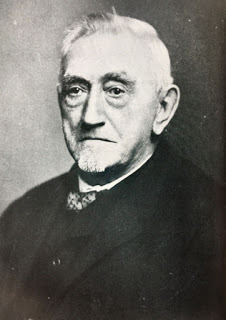 Nicholas Thomas. Source: Drury, History of City of Dayton, 971.
Nicholas Thomas. Source: Drury, History of City of Dayton, 971.In January 1848, despite what historians described as bitterly cold weather, Thomas walked to Dayton in stocking feet, carrying his boots in a pack. And this wasn't the end: after a couple of weeks, he resumed his trek to an uncle's farm in Decatur, Indiana. I didn't discover what route he took, but the straight-line distance between Dayton and Decatur and is more than 80 miles. My guess is that he followed the towpath of the Miami and Erie Canal for much of the distance. Months later, he came back the same way, although he finished the trip on a canalboat.
Thomas was big and tough. Even late in his life, published reports described him as a 230-pound man with a "splendid physique." And he worked hard jobs before taking over the Hydraulic Brewery—a former sawmill at First and Beckel Streets—in his mid-50s. Even in winter, long walks on a graded path wouldn't have been too much of a challenge for him.
But why in the world would he go in stocking feet, in the winter, with his boots on his back? Local historians who recounted Thomas' unshod journey gave no explanation. But I have a hunch. And it's where my brain makes the connection between Thomas and The Barrel House, or more accurately the 400 block of East Third.
I made my first wilderness trip in the early 1970s when I was still in college. Outfitting stores then were few and far between, at least in Ohio, and I was a backwoods noob. So I geared up at the local Army & Navy Surplus, a store that had been around since 1947. An outlet for excess military clothes and gear that evolved into an outfitting shop, it occupied the now-vacant storefront at 401 E. Third, next to The Barrel House.
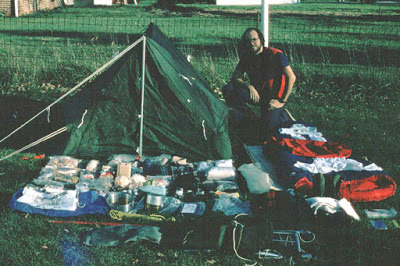 This was how I geared up in the early 1970s, some of it from Army & Navy Surplus.
This was how I geared up in the early 1970s, some of it from Army & Navy Surplus.One of the many things I would learn about was footwear. My first real backpacking boots were full-grain leather Vasques that might have been made of cast iron. I bought them for my first backpacking trip in the Great Smoky Mountains, but first I wore them on several short hikes until I had them broken in—or so I thought.
As I wound my way up real mountain trails, even silk liners under thick wool socks didn't keep those Vibram-soled monsters from chafing my feet. I grew blisters on top of blisters. My feet would swell at night, and the next morning I would grit my teeth against the pain of squeezing them back into those cold, stiff boots. Fortunately, the splendor of the Smoky Mountain backcountry in late autumn took my mind off the pain as I hiked, and after five days my boots and my feet were coming to terms.
That experience came to mind when I read about Nick Thomas's trek. My hunch is that he picked up his boots somewhere between Germany and Cincinnati. No doubt life on a farm had conditioned his feet for the ground, but maybe not for new, stiff boots.
Gearing up at the surplus store is one of many memories I have of The Barrel House neighborhood. The Dayton Metro Library has been a big part of my life, of course, but I also remember stopping for butter burgers at the White Tower restaurant next to the surplus store, before it became the White Lotus.
I'll have more to say about Nick Thomas and other early brewers on Thursday. On Friday, Aug. 23, I'll be at Star City Brewing in Miamisburg, where I'll focus on Miamisburg's long-forgotten brewers. Here's a link to my full tour schedule.
Published on August 12, 2019 09:09
August 5, 2019
Dayton: Strong, scarred, surviving


© 2019 Timothy R. Gaffney
I had planned to sit down Sunday morning and write my weekly blog about Dayton's brewing history.
Instead, I awoke to the horrific news of a mass shooting in the city's historic Oregon District—the second in our country in less than 24 hours, the 250th this year alone.
The ability to write or do anything meaningful seemed to drain out of me. Brewing history seemed irrelevant.
Over the course of the day, I reflected on what I had learned about Dayton in looking through more than two centuries of its history, and what meaning I might draw from it.
I had learned Dayton—and by Dayton, I mean the Dayton region—was settled and built by tough, resilient people. People who weathered incredible hardships just to get here, and more to build lives for themselves, their families and their community.
This is the worst mass shooting of which I'm aware in Dayton's history. It will leave a scar on all of us, and on the city. But under the scar, we will heal. We will go on, as we must.
I will go on with my book tour, beginning Wednesday at Warped Wing Brewing Co. I'll share some better pages from Dayton's history, and I hope you'll join me. Bring a copy of my book and I'll sign it, and I'll have books available for sale.
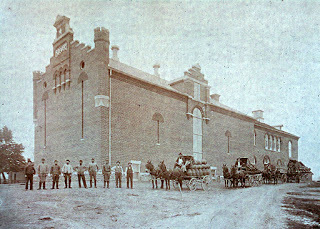 Undated photo of Minster Star Brewery. Courtesy Minster Historical Society.
Undated photo of Minster Star Brewery. Courtesy Minster Historical Society.In the meantime, my tour has grown. I've added two non-pub events: 4 p.m. Saturday, September 7, at Barnes & Noble Booksellers at the Dayton Mall, and 7 p.m. Thursday, Nov. 7, at the Auglaize County Historical Society's annual meeting, where I'll focus on the brewing histories of Minster, New Bremen and Wapakoneta.
Thanks to WDTN TV-2's Living Dayton for having me on to talk about my book tour last week, and for posting the segment so I could share it. And thanks to Vick Mickunas for having me on his Book Nook program on 91.3 WYSO, and featuring Dayton Beer in his Sunday column in the Dayton Daily News.
Copies are now available for sale at Carillon Brewing Co. in Dayton History's Carillon Historical Park as well as the park's gift shop.
Below is my updated schedule, and here's a link to an updated downloadable flyer that you can print and display.
Wednesday Aug 7—5:00 pmWarped Wing Brewing Co.26 Wyandot St. Dayton
Thursday Aug 15—5:30 pmThe Barrel House417 E. Third St. Dayton
Friday Aug 23—5:30 pmStar City Brewing Co.320 S. 2nd St. Miamisburg
Saturday Sep 7—4 pmBarnes & Noble Dayton2619 Miamisburg-Centerville Road, Miami Twp.Tuesday Sep 10—6 pm
Eudora Brewing Co.
3022 Wilmington Pike, DaytonWednesday Sep 18—6 pmLock 27 Brewing329 E. First St. Dayton
Saturday, Oct 5—3 pmCarillon Brewing Co.1000 Carillon Blvd. Dayton
Saturday, Oct 12—1 pmMoeller Brew Barn-Maria Stein8016 Marion Dr. Maria Stein
Thursday Oct 17—6 pmMother Stewart's Brewing109 W. North St. Springfield
Thursday Nov. 7—7 pm
Auglaize County Historical Society
206 W. Main St., Wapakoneta
About Dayton BeerTitle: Dayton Beer: A History of Brewing in the Miami ValleyPublisher: The History PressISBN: 9781467138925Retail price: $21.99Format: 6x9, softcover, 192 pagesRelease date: Now available
Published on August 05, 2019 04:00
July 29, 2019
Where brewing began in Dayton

 Warped Wing and Barrel House are in the heart of Dayton's original brewing district.
Warped Wing and Barrel House are in the heart of Dayton's original brewing district.© 2019 Timothy R. Gaffney
When you visit the Warped Wing Brewing Co. or The Barrel House in downtown Dayton—as I will on Aug. 7 and Aug. 15—you journey to the heart of Dayton's Historic Brewing District.
Warped Wing occupies a former foundry building at 26 Wyandot Street, just south of East Main between North Patterson Boulevard and Wayne Avenue. The Barrel House is in an old commercial building at 417 E. Third. They're both close to where Dayton's founders built their first cabins and close to where its first breweries opened.
George Newcom, one of Dayton's original settlers, built his cabin on the southwest corner of Main and Monument in 1796 and later enlarged it into a two-story tavern. He added a brewery about 1810. It was Montgomery County's first brewery, according to historian Augustus Waldo Drury.
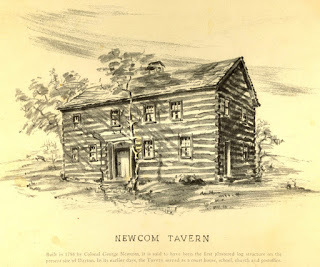 Sketch of Newcom Tavern, from Lutzenberger Picture Collection, Dayton Metro Library.Henry Brown built Dayton's first brick brewery about 1820 on the south side of Second west of Jefferson. It became known as the Dayton Brewery.
Sketch of Newcom Tavern, from Lutzenberger Picture Collection, Dayton Metro Library.Henry Brown built Dayton's first brick brewery about 1820 on the south side of Second west of Jefferson. It became known as the Dayton Brewery. A later owner, George C. Davis, moved the business in 1828 to the west side of Jefferson, midway between First and Monument. John W. Harries took it over shortly after arriving with his family in 1829. He owned it until his death in 1873.
Even closer were the breweries of James Riddle and Henry Ferneding. Riddle was an Indiana Mounted Ranger in the War of 1812 who came to Dayton sometime in the 1820s, if not earlier. Exactly when he started a brewery isn't clear, but he was in business by 1840 on St. Clair near East Third.
Ferneding worked for Riddle before opening his City Brewery on the east side of Kenton near East Third. In 1859, he built a new brewery a mile south on the west side of Warren, just south of Apple. He closed the old brewery but kept a malt house on Kenton.
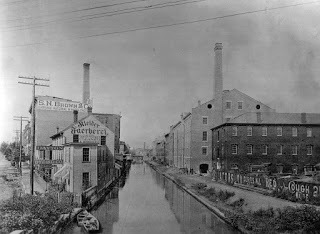 Sachs-Pruden, with tall chimney on right, skirted the Miami and Erie Canal—now Patterson Boulevard.
Sachs-Pruden, with tall chimney on right, skirted the Miami and Erie Canal—now Patterson Boulevard.The breweries of Brown, Harries, Riddle and Ferneding are long gone. Newcom Tavern is now at Carillon Historical Park, where it's a neighbor of the reproduction 1850s brewery Carillon Brewing Co. But one brewery still stands close to Warped Wing and the Barrel House—the former Sachs-Pruden brewery at 120 South Patterson. It's now the Dayton Metro Library's administration building.
While most of Dayton's old breweries are gone, their stories remain, and I retell them in my book Dayton Beer . Join me at Warped Wing on Wednesday, Aug. 7, starting at 5 p.m., for its official release and the launching of my History and a Pint™ book tour. I'll be at The Barrel House a week later on Thursday, Aug. 15, starting at 5:30. Bring your copy and I'll sign it, and I'll have books available for sale.
In case you miss me at either location, here's the full tour schedule:
Wednesday Aug 7—5:00 pm
Warped Wing Brewing Co.
26 Wyandot St. Dayton
Thursday Aug 15—5:30 pm
The Barrel House
417 E. Third St. Dayton
Friday Aug 23—5:30 pm
Star City Brewing Co.
320 S. 2nd St. Miamisburg
Tuesday Sep 10—6 pm
Eudora Brewing Co.
3022 Wilmington Pike, Dayton
Wednesday Sep 18—6 pm
Lock 27 Brewing
329 E. First St. Dayton
Saturday, Oct 5—3 pm
Carillon Brewing Co.
1000 Carillon Blvd. Dayton
Saturday, Oct 12—1 pm
Moeller Brew Barn-Maria Stein
8016 Marion Dr. Maria Stein
Thursday Oct 17—6 pm
Mother Stewart's Brewing
109 W. North St. Springfield
Published on July 29, 2019 03:07
July 24, 2019
Dayton Beer author plans unique book tour
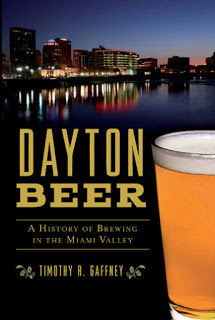 p.p1 {margin: 0.0px 0.0px 0.0px 0.0px; font: 17.0px Arial; -webkit-text-stroke: #000000} p.p2 {margin: 0.0px 0.0px 0.0px 0.0px; font: 10.0px Arial; -webkit-text-stroke: #000000; min-height: 11.0px} p.p3 {margin: 0.0px 0.0px 0.0px 0.0px; font: 12.0px Arial; -webkit-text-stroke: #000000} p.p4 {margin: 0.0px 0.0px 0.0px 0.0px; font: 12.0px Arial; color: #4787ff; -webkit-text-stroke: #4787ff} p.p5 {margin: 0.0px 0.0px 0.0px 0.0px; font: 12.0px Arial; -webkit-text-stroke: #000000; min-height: 14.0px} p.p6 {margin: 0.0px 0.0px 0.0px 0.0px; font: 14.0px 'Times New Roman'; -webkit-text-stroke: #000000; min-height: 16.0px} p.p7 {margin: 0.0px 0.0px 0.0px 0.0px; font: 17.0px 'Times New Roman'; -webkit-text-stroke: #000000} p.p8 {margin: 0.0px 0.0px 0.0px 0.0px; font: 14.0px 'Times New Roman'; -webkit-text-stroke: #000000} p.p9 {margin: 0.0px 0.0px 0.0px 0.0px; font: 14.0px 'Times New Roman'; color: #323333; -webkit-text-stroke: #323333} p.p10 {margin: 0.0px 0.0px 0.0px 0.0px; font: 14.0px 'Times New Roman'; color: #323333; -webkit-text-stroke: #323333; min-height: 16.0px} span.s1 {font-kerning: none} span.s2 {font-kerning: none; color: #000000; -webkit-text-stroke: 0px #000000} span.s3 {text-decoration: underline ; font-kerning: none; -webkit-text-stroke: 0px #4787ff} span.s4 {font-kerning: none; color: #1e497d; -webkit-text-stroke: 0px #1e497d} span.s5 {text-decoration: underline ; font-kerning: none} span.s6 {font: 12.0px 'Times New Roman'; font-kerning: none} span.s7 {font: 14.0px Times; font-kerning: none; color: #25282c; -webkit-text-stroke: 0px #25282c} span.s8 {font-kerning: none; -webkit-text-stroke: 0px #000000}
p.p1 {margin: 0.0px 0.0px 0.0px 0.0px; font: 17.0px Arial; -webkit-text-stroke: #000000} p.p2 {margin: 0.0px 0.0px 0.0px 0.0px; font: 10.0px Arial; -webkit-text-stroke: #000000; min-height: 11.0px} p.p3 {margin: 0.0px 0.0px 0.0px 0.0px; font: 12.0px Arial; -webkit-text-stroke: #000000} p.p4 {margin: 0.0px 0.0px 0.0px 0.0px; font: 12.0px Arial; color: #4787ff; -webkit-text-stroke: #4787ff} p.p5 {margin: 0.0px 0.0px 0.0px 0.0px; font: 12.0px Arial; -webkit-text-stroke: #000000; min-height: 14.0px} p.p6 {margin: 0.0px 0.0px 0.0px 0.0px; font: 14.0px 'Times New Roman'; -webkit-text-stroke: #000000; min-height: 16.0px} p.p7 {margin: 0.0px 0.0px 0.0px 0.0px; font: 17.0px 'Times New Roman'; -webkit-text-stroke: #000000} p.p8 {margin: 0.0px 0.0px 0.0px 0.0px; font: 14.0px 'Times New Roman'; -webkit-text-stroke: #000000} p.p9 {margin: 0.0px 0.0px 0.0px 0.0px; font: 14.0px 'Times New Roman'; color: #323333; -webkit-text-stroke: #323333} p.p10 {margin: 0.0px 0.0px 0.0px 0.0px; font: 14.0px 'Times New Roman'; color: #323333; -webkit-text-stroke: #323333; min-height: 16.0px} span.s1 {font-kerning: none} span.s2 {font-kerning: none; color: #000000; -webkit-text-stroke: 0px #000000} span.s3 {text-decoration: underline ; font-kerning: none; -webkit-text-stroke: 0px #4787ff} span.s4 {font-kerning: none; color: #1e497d; -webkit-text-stroke: 0px #1e497d} span.s5 {text-decoration: underline ; font-kerning: none} span.s6 {font: 12.0px 'Times New Roman'; font-kerning: none} span.s7 {font: 14.0px Times; font-kerning: none; color: #25282c; -webkit-text-stroke: 0px #25282c} span.s8 {font-kerning: none; -webkit-text-stroke: 0px #000000} For Immediate Release
July 24, 2019For interviews and events, contact Timothy R. Gaffney937.219.8277 | daytonbeerbook@gmail.com
For review copies, contact Erin Owens, Senior Publicist843.853.2070 x214 | eowens@arcadiapublishing.com
Editors: Contact Timothy R. Gaffney for a digital press kit with additional information and a selection of press-quality photos, including an author photo and book cover image.
History… and a Pint? Dayton Beer author plans unique book tour
DAYTON, Ohio—A one-of-a-kind book tour will kick off Wednesday, Aug. 7 at Warped Wing Brewing Co. in downtown Dayton.
Instead of book shops, the “History and a PintTM” tour by local author Timothy R. Gaffney will stop exclusively at brewpubs and tap houses across the Dayton region.
The reason? Gaffney’s new book, Dayton Beer: A History of Brewing in the Miami Valley (The History Press, $21.99) is focused on the 200-plus year history of beer brewing in the Miami Valley. What better way to talk about brewing history than over a pint of beer?
Warped Wing, at 26 Wyandot Street downtown, is in the heart of Dayton’s original brewing district, close to where Irish immigrant George Newcom built Dayton’s first brewery about 1810.
Gaffney will describe the brewing industry that flourished in Dayton and surrounding communities until the 19th Amendment—Prohibition—signaled its doom one century ago this year. He will also explore the aftermath of Prohibition and the rebirth of local breweries in the last decade. Books will be available for sale.
Following the kickoff at Warped Wing, Gaffney will be at The Barrel House, 417 E. Third St., at 5:30 on Aug. 15 and at Star City Brewing, 320 S. 2nd St. in Miamisburg, at 5:30 p.m. on Aug. 23.
Here are the other tour stops:
Sept. 10: Eudora Brewing Co., 3022 Wilmington Pike, KetteringSept. 18: Lock 27 Brewing, 329 E. First St., DaytonOct 5.: Carillon Brewing, Carillon Historical Park, DaytonOct. 12: Moeller Brew Barn, Maria Stein, Mercer CountyOct. 17: Mother Stewart's Brewing, 102 W. Columbia St., Springfield
About the authorTimothy R. Gaffney was born in Dayton in 1951 and has lived in the Miami Valley most of his life. After earning a bachelor’s degree from The Ohio State University in Columbus in 1974, he worked for the Piqua Daily Call, the Kettering-Oakwood Times and the Dayton Daily News, where he retired in 2007. Since then he has held positions as assistant media relations director for Wright State University and director of communications for the National Aviation Heritage Area. He is a volunteer trustee for the United States Air and Trade Show Inc., the nonprofit producer of the Vectren Dayton Air Show. He lives in Miamisburg, Ohio, with his wife, Jean. They have four grown children, two grandchildren and two dogs.
About Dayton BeerTitle: Dayton Beer: A History of Brewing in the Miami ValleyPublisher: The History Press, Mt. Pleasant, SCISBN: 9781467138925Retail price: $21.99Format: 6x9, softcover, 192 pagesRelease date: Now available

Published on July 24, 2019 04:40



